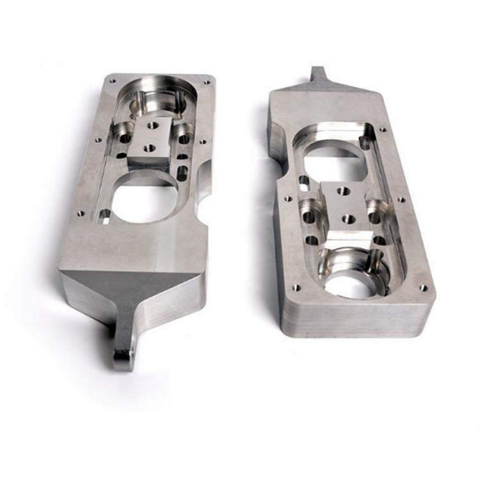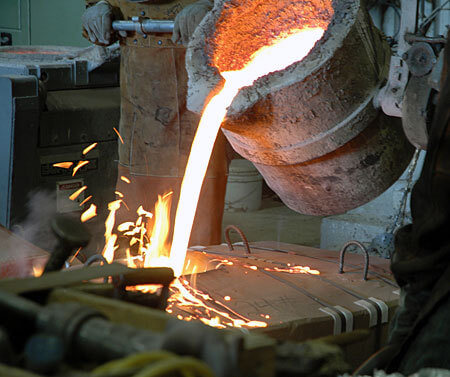Understanding Quality Control in aluminum casting
Aluminum Casting Explained: Secret Realities and Insights for Market Professionals
Aluminum casting functions as an essential process in modern manufacturing, forming parts across numerous industries. Its diverse techniques, such as sand and die casting, accommodate different manufacturing needs. The distinct residential or commercial properties of aluminum alloys enhance their applicability, yet tests stay in preserving quality and efficiency. Recognizing these elements is crucial for sector specialists. What are the most recent developments and ideal methods that can additionally enhance this procedure?
Introduction of Aluminum Casting Processes

Crucial element of aluminum casting processes include the prep work of molds, which might be made from sand, steel, or ceramic products, depending upon the intended use. Furthermore, temperature level control is critical to guarantee correct melting and solidification of aluminum.
The casting process enables complex styles and can achieve high degrees of dimensional accuracy. Once cooled down, the spreadings may undergo finishing procedures such as machining or surface area therapy to meet particular efficiency requirements. On the whole, aluminum casting serves as a versatile production technique, successfully meeting the varied needs of various markets.
Sorts Of Aluminum Casting Techniques
In the domain name of aluminum casting, various techniques are utilized to attain various results. Sand casting methods give adaptability and cost-effectiveness for intricate forms, while die casting processes offer high accuracy and efficiency for automation. Understanding these techniques is important for selecting the proper strategy based upon task needs.
Sand Casting Techniques
Sand casting techniques represent a basic approach in aluminum casting, where sand is used as a mold and mildew material to shape liquified steel. This procedure involves creating a pattern from the desired component, which is after that positioned in a sand combination to form a mold and mildew. The sand is compacted around the pattern, and after removal, it creates a tooth cavity in the shape of the component. Molten aluminum is put into this tooth cavity, enabling it to cool and solidify. One substantial advantage of sand casting is its versatility; it can suit complex shapes and large parts. In addition, the materials used are fairly inexpensive, making it an accessible alternative for various manufacturing applications in the aluminum industry.
Die Casting Processes
Die casting processes are a popular method for forming aluminum components, utilizing high-pressure strategies to force molten steel into specifically crafted molds. This process is specifically preferred for its capability to produce complex shapes with limited tolerances and a smooth coating. There are 2 key types of die casting: warm chamber and chilly chamber. Warm chamber die casting appropriates for steels with reduced melting factors, enabling faster production rates. Alternatively, cool chamber die casting is suitable for higher melting point steels, calling for a different melting heating system. Both techniques boost performance and reduce material waste, making them essential in vehicle, aerospace, and durable goods sectors. Recognizing these processes helps experts choose one of the most appropriate strategy for their particular applications.
Material Feature of Aluminum Alloys

Strength and Durability
Strength and resilience are vital characteristics of aluminum alloys that make them suitable for different casting applications. These products display a beneficial strength-to-weight ratio, enabling the production of lightweight yet robust elements. When it come to tensile toughness, details aluminum alloys can be engineered to withstand considerable tons without flawing. This building is specifically important in markets such as aerospace and vehicle, where efficiency and security are paramount. In addition, aluminum alloys frequently preserve their mechanical residential properties under varied temperature level conditions, guaranteeing regular performance. The inherent ductility of these alloys also enables effective shaping during the casting process, making it simpler to generate complex geometries. In general, the toughness and toughness of aluminum alloys contribute considerably to their widespread usage in sophisticated applications.
Corrosion Resistance Characteristics
While aluminum alloys are treasured for their strength and lightweight buildings, their corrosion resistance is an additional vital characteristic that improves their viability for numerous applications. Aluminum normally forms a safety oxide layer when subjected to moisture, which helps to avoid additional oxidation. This inherent building makes aluminum alloys particularly useful in environments vulnerable to rust, such as commercial and aquatic settings. Additionally, different alloy compositions can influence resistance degrees, with certain alloys particularly crafted to enhance this characteristic. Therapies like plating can further boost aluminum casting deterioration resistance by enlarging the oxide layer. Subsequently, understanding the corrosion resistance of aluminum alloys is crucial for market experts when picking products for projects needing toughness and long life in tough settings.
Advantages of Aluminum Casting in Manufacturing
Aluminum casting deals countless advantages in production, making it a recommended choice for numerous sectors. One significant benefit is its lightweight nature, which adds to reduced transport prices and enhanced power performance in final result. In addition, aluminum's outstanding thermal and electrical conductivity improves capability in applications requiring warmth dissipation or electric conduction.
The product's capability to be cast into intricate forms enables design versatility, minimizing the need for additional machining procedures. In enhancement, aluminum casting shows premium rust resistance, leading to longer product lifespans and lower maintenance prices.

Typical Applications of Aluminum Castings
The flexibility of aluminum casting enables its extensive usage across different industries. Common applications include vehicle components, where light-weight and corrosion-resistant elements, such as engine blocks and transmission real estates, enhance car performance. In the aerospace market, aluminum castings are made use of for architectural elements, supplying toughness without adding significant weight.
Additionally, the electric market take advantage of aluminum spreadings in manufacturing enclosures and warm sinks, where thermal conductivity is crucial. The consumer products field additionally incorporates aluminum spreadings in products like pots and pans, furnishings, and decorative products, incorporating visual appeals with functionality.
The building and construction sector uses aluminum spreadings for building elements, home window structures, and components, which offer toughness and design flexibility. In general, the varied applications of aluminum spreadings emphasize their relevance in modern-day production, contributing to developments in efficiency and item style across numerous fields.
Advancements and Technological Innovations
As markets remain to advance, developments in aluminum casting technology are transforming manufacturing processes and product capacities. Improvements in 3D printing and additive manufacturing have actually made it possible for the production of complex geometries that were formerly impossible to attain with conventional methods. These innovations allow for quick prototyping, minimizing lead times and expenses.
In addition, enhancements in mold design and materials have boosted the casting process by increasing efficiency and decreasing waste. The integration of smart manufacturing strategies, such as IoT devices and real-time data analytics, enables better tracking and optimization of manufacturing specifications, leading to better outcomes.
Developments in aluminum alloys offer enhanced stamina, deterioration resistance, and light-weight residential properties, catering to the expanding demands in aerospace and vehicle fields. Jointly, these developments are not only boosting efficiency but additionally satisfying the strenuous standards of modern engineering applications.
Finest Practices for Top Quality Control in Aluminum Casting
Making certain high-quality results in aluminum casting calls for adherence to best methods that include various stages of the production process. Initially, detailed material inspection is important to validate the high quality of aluminum alloys made use of, as contaminations can significantly affect the end product. Carrying out precise melting and putting methods minimizes problems; maintaining excellent temperatures avoids oxidation and advertises harmony.
Mold style plays an important function; making use of computer-aided style (CAD) can enhance precision and minimize human mistake. Routine surveillance of the cooling process is essential to stay clear of warping and contraction. In addition, making use of non-destructive testing approaches, such as ultrasonic or X-ray examinations, assists determine inner imperfections without damaging the parts.
Establishing a feedback loophole with engineers and drivers promotes constant improvement, making certain that quality control measures advance alongside technical improvements. By following these ideal techniques, producers can enhance the dependability and efficiency of aluminum spreadings.
Frequently Asked Concerns
What Are the Ecological Influences of Aluminum Casting?
The environmental influences of aluminum casting consist of substantial power consumption, greenhouse gas discharges, and prospective water contamination from shop procedures. Furthermore, bauxite mining for aluminum ore can lead to environment devastation and dirt destruction.
Just How Does Aluminum Casting Compare to Other Metal Casting Processes?
Aluminum casting normally provides advantages in lightweight components and deterioration resistance contrasted to various other processes, such as iron or steel casting, which may provide higher strength but cause heavier and less corrosion-resistant products. - aluminum casting
What Are Common Problems in Aluminum Castings and Their Causes?
Common issues in aluminum castings include porosity, shrinkage, and incorporations. Causes typically originate from incorrect putting strategies, poor mold and mildew style, or contamination of the liquified metal, influencing the final item's stability and performance.
What Safety and security Safety Measures Should Be Taken During Aluminum Casting?
During aluminum casting, vital security precautions include wearing safety equipment, guaranteeing proper air flow, keeping a tidy work area, dealing with liquified steel with care, and following well-known methods to lessen risks of burns, breathing dangers, and accidents.
Just How Can I Enhance the Efficiency of My Aluminum Casting Procedures?
To enhance efficiency in aluminum casting procedures, one ought to optimize mold and mildew design, simplify material handling, employ automated procedures, carry out regular upkeep on equipment, and spend in worker training to boost skills and productivity.
Different methods exist, aluminum casting incorporates several key processes that provide to various applications and needs. Secret aspects of aluminum casting processes include the prep work of molds, which might be made from sand, metal, or ceramic products, depending on the planned use. Sand casting strategies represent a basic method in aluminum casting, where sand is utilized as a mold and mildew product to shape liquified steel. As markets continue to progress, innovations in aluminum casting innovation are changing production processes and product capacities. Guaranteeing high-grade outputs in aluminum casting needs adherence to ideal practices that include numerous stages of the production process.